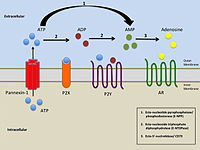| Part of a series on |
| Purinergic signalling |
|---|
 |
| Concepts |
| Membrane transporters |
Purinergic receptors, also known as purinoceptors, are a family of plasma membrane molecules that are found in almost all mammalian tissues.[1] Within the field of purinergic signalling, these receptors have been implicated in learning and memory, locomotor and feeding behavior, and sleep.[2] More specifically, they are involved in several cellular functions, including proliferation and migration of neural stem cells, vascular reactivity, apoptosis and cytokine secretion.[2][3] These functions have not been well characterized and the effect of the extracellular microenvironment on their function is also poorly understood.
Geoff Burnstock originally separated purinoceptors into P1 adenosine receptors and P2 nucleotide (ATP, ADP) receptors.[4] P2 receptors were later subdivided into P2X, P2Y, P2T, and P2Z receptors.[5] Subclasses X and Y mediated vasoconstriction and vasodilation, respectively, in the smooth muscle of some arteries. They had been observed in blood vessels, smooth muscle, heart, hepatocytes, and parotid acinar cells. Subclass T was only observed in thrombocytes, platelets and megakaryocytes. Subclass Z required ~100 μM-ATP for activation, where the previous classes required <1 μM. They had been observed in mast cells and lymphocytes.
In the early 1990s, purinoceptors were cloned and characterized, and the P2 subclasses were redefined.[4] Now, P2 receptors are classified based on structure: P2X are ionotropic and P2Y are metabotropic. Appropriately, P2Z was reclassified as P2X7[6] and P2T was reclassified as P2Y1.[7]
- ^ North RA (October 2002). "Molecular physiology of P2X receptors". Physiological Reviews. 82 (4): 1013–1067. doi:10.1152/physrev.00015.2002. PMID 12270951.
- ^ a b Burnstock G (2013). "Introduction to Purinergic Signalling in the Brain". Glioma Signaling. Advances in Experimental Medicine and Biology. Vol. 986. pp. 1–12. doi:10.1007/978-94-007-4719-7_1. ISBN 978-94-007-4718-0. PMID 22879061.
- ^ Ulrich H, Abbracchio MP, Burnstock G (September 2012). "Extrinsic purinergic regulation of neural stem/progenitor cells: implications for CNS development and repair". Stem Cell Reviews and Reports. 8 (3): 755–767. doi:10.1007/s12015-012-9372-9. PMID 22544361. S2CID 10616782.
- ^ a b Burnstock G (January 2014). "Purinergic signalling: from discovery to current developments". Experimental Physiology. 99 (1): 16–34. doi:10.1113/expphysiol.2013.071951. PMC 4208685. PMID 24078669.
- ^ Gordon JL (January 1986). "Extracellular ATP: effects, sources and fate". The Biochemical Journal. 233 (2): 309–319. doi:10.1042/bj2330309. PMC 1153029. PMID 3006665.
- ^ Surprenant A, Rassendren F, Kawashima E, North RA, Buell G (May 1996). "The cytolytic P2Z receptor for extracellular ATP identified as a P2X receptor (P2X7)". Science. 272 (5262): 735–738. doi:10.1126/science.272.5262.735. PMID 8614837.
- ^ Léon C, Hechler B, Vial C, Leray C, Cazenave JP, Gachet C (February 1997). "The P2Y1 receptor is an ADP receptor antagonized by ATP and expressed in platelets and megakaryoblastic cells". FEBS Letters. 403 (1): 26–30. Bibcode:1997FEBSL.403...26L. doi:10.1016/S0014-5793(97)00022-7. PMID 9038354.